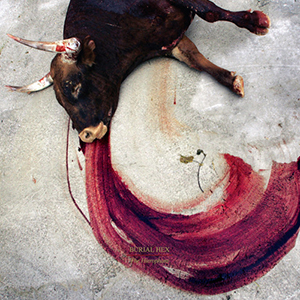Burial Hex, "The Hierophant"
 As the final full length release to be released by Clay Ruby under his Burial Hex moniker, The Hierophant is an appropriately dramatic tombstone for the enigmatic project. Esoteric shades of noise and blackened metal color the middle portions of the record, bookended by two gloriously perverse, almost pop songs that standout as both baffling and utterly compelling.
As the final full length release to be released by Clay Ruby under his Burial Hex moniker, The Hierophant is an appropriately dramatic tombstone for the enigmatic project. Esoteric shades of noise and blackened metal color the middle portions of the record, bookended by two gloriously perverse, almost pop songs that standout as both baffling and utterly compelling.
It is these lengthy opening and closing songs that really grabbed me most of all with this record."Winter Dawn" may begin with dramatic, flowery synths and electronics, but when the chiming electric guitar and deep, thudding drum machine appear early on, it becomes gripping and catchy.Once Ruby's vocals appear, the song begins to feel like a brilliant slice of post-punk synth pop, with shades of most of the artists of that era, but never really resembling anything but Burial Hex.
The 15 minute conclusion to the album, "The Most Foolish Son is Always the Oldest One," first has Ruby leading in with violin over cricket field recordings, a mood that is quickly shifted once the beat and synth sequence drop in.From there the song evolves into an oddly upbeat and poppy number with some slight neofolk and goth flourishes, and even a hint of psychedelia.With his voice channeling Nick Cave in a superlative manner, the piece builds to a sweeping conclusion that is a fitting climax for the album, and likely project as a whole.These two pieces feature Nathanial Ritter and Troy Schafer of Wisconsin contemporaries Kinit Her, with Schafer contributing the string and brass arrangements throughout the entire album.
The three pieces sandwiched between these two are in no way lacking, but work on a different, more experimental level."Final Love" has Ruby retaining the synthetic programmed rhythms from the preceding "Winter Dawn," but with guttural vocals and dark, metallic noises throughout.Clay lightens up a bit once strings and piano sounds appear in the song's latter half, but it never really lightens and instead stays foreboding throughout.
The title song, sitting as the centerpiece of the album, draws more from the dramatic and dissonant parts of the album more so than the song oriented moments.Again, growling demonic vocals appear amidst walls of electronics and dramatic expanses of violin, and never does a concession to pop music arise."Never Dying," on the other hand, embraces minimalism and subtlety.Over a bed of evening field recordings (the same ones that lead into "The Most Foolish Son…") he works in delicate piano and whispered vocals.It sticks to this structure for most of the piece, but with the understated nature the piece conveys a different style of intensity, one that seems ready to burst out maliciously at any moment.
I am not sure what Clay Ruby's post-Burial Hex plans may be as far as music goes, but based on the strength of the opening and ending pieces of this album, I sincerely hope he goes for something more traditionally oriented.While the more experimental and abstract moments of The Hierophant are excellent, it is on the other two that I caught myself especially captivated by that sound that manages to be both musical and non-musical at the same time.Memorable, yet unlike anyone else, they make for an intense shine on an already brilliant record, and one that closes Burial Hex's existence appropriately.
samples:
 



